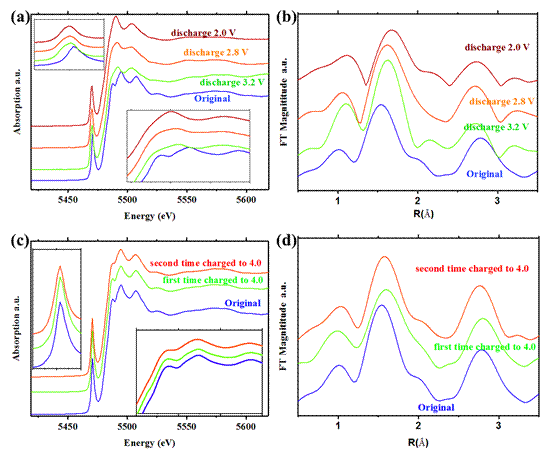| Illumining phase transformation dynamics of vanadium oxide cathode by multimodal techniques under operando conditions |
| From: PublishDate:2020-07-31 Hits: |
Subtle structural changes during electrochemical processes are often related to the degradation of the electrode materials. Accurately tracking the minute variations such as crystal structure, chemical bonds, and electron/ion conductivity under typical battery operating conditions will give an in-depth understanding on the reaction mechanism of electrode materials, as well as reveal pathways for optimization. A team from Wuhan University of Technology used a typical cathode material, vanadium pentoxide (V2O5), which suffers from severe capacity decay during cycling, as prototype. Their research has been published in April, 2019 in Nano Research. The team studied the phase transitions of V2O5 with an elemental molar ratio of Li/V within a range of 0-1. First, they investigated the evolution of V2O5 cathode by in-situ X-ray diffraction (XRD) and in-situ Raman spectroscopy combined with electrochemical tests. Further fine studies through XANES and EXAFS confirmed that the V–O and V–V distances became more extended and shrank compared to the original ones after charge/discharge process, respectively. These variations are vital to the crystal structure cracking and correlated to capacity fading. "Our results are in agreement with a study, in which in-situ XRD, in situ Raman, and ex situ XAFS characterization of V2O5 model electrode material revealed that chemical bonding in V-O layers plays a vital role during electrochemical cycling and that breaking of the metal-oxygen and metal-metal bonds may be the origin of the capacity fading" evaluated by Ekaterina Pomerantseva: ACS Appl. Energy Mater. 2020, 3, 1, 1063–1075 https://pubs.acs.org/doi/abs/10.1021/acsaem.9b02098
The ex situ XAFS results of lithiation process (a and b) and the after lithiation (c and d) V2O5, obtained at 1W1B-XAFS station of Beijing Synchrotron Radiation Facility (BSRF). The structure became disorderly and larger during the lithiation. After the second discharge, accompanied by lithium ions removed again from the V2O5 structure skeleton. This body was more unstable, the V-O distance became slightly larger again, V-V became larger, and the strength of the coordination polyhedron became lower, indicating that the structure changed to more disordered level. Prof. Liqiang Mai explained that "This work demonstrates that chemical bond changes between the transition metal and oxygen upon cycling serve as the origin of the capacity fading. This is an interesting finding and this can disclose hidden phenomena". Prof. Mai is the principal investigator of the research team from Wuhan University of Technology. cNano Research, 2019, 12, 905–910. Article: Guobin Zhang§, Tengfei Xiong§, Xuelei Pan , Yunlong Zhao*, Mengyu Yan*, Haining Zhang, Buke Wu, Kangning Zhao and Liqiang Mai. Illumining phase transformation dynamics of vanadium oxide cathode by multimodal techniques under operando conditions. Nano Research, 2019, 12, 905–910. onditions. |
|
|
| Chinese
- Metal-free efficient photocatalyst for stable visible water splitting——Top ten major scientific progresses in China in 2015
- The nano-resolution imaging platform was awarded the first rate prize of Beijing Science and Technology in 2014
- Beamline 1W1 of BSRF started to runoperate in the couplingparasitic mode of BEPCII
- Synthesis of High Performance Polymer Materials for Field Effect-Transistors
- Surfactant molecular aggregates in green solvents
- GIXRD has played an important role in the characterization of organic thin-film transistors
Copyright © 2011 - 2012 Beijing Synchrotron Radiation Facility


